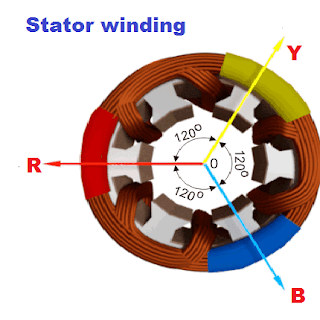The stator of an induction motor consists of a number of overlapping windings offset by an electrical angle of 120°. When the primary winding or stator is connected to a three-phase alternating current supply, it establishes a rotating magnetic field that rotates at a synchronous speed.
The waveform of the three fluxes is given below.
The three-phase winding carries the balance current if the applied sinusoidal voltage is balanced and the impedance of each winding is also balanced. The stator winding is physically placed 120 electrical degrees apart, as shown in the figure below.

If the phase sequence is R, Y, B, the Y phase current lags the R phase current by 120 degrees, and the B phase current lags the Y phase current by 120 degrees or leads the R phase current by 120 degrees. The phase currents Ir, Iy, and Ib set up flux in the core. The resultant magnitude of the average flux can be calculated by adding the magnetic flux produced by individual currents.
Let us first take the case when the R phase current is at the zero position of the waveform. The flux produced by the R phase current is Фr.
Фr = Фm sin(o) = 0
Фy = Фm sin(0-120) =Фm sin(-120) = – 0.866 Фm
Фb = Фm sin(0-240) =Фm sin(-240) = 0.866 Фm
If we add the instantaneous value of the fluxes produced by phase voltages, the resultant flux in the motor
Average flux= 1.5 * Maximum Flux
The average flux of constant magnitude rotates in the same way as the input three supply phases rotate.
2 thoughts on “Rotating Magnetic Field in Three Phase Induction Motor”